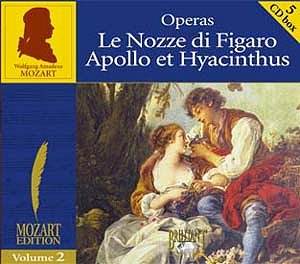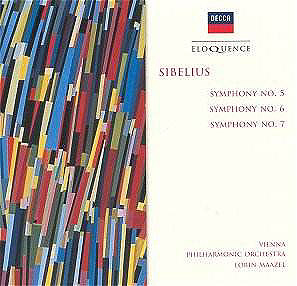 Composer: Wolfgang Amadeus Mozart
Composer: Wolfgang Amadeus Mozart
Works: Le Nozze di Figaro, Apollo et Hyacinthus
Performers: Il Conte di Almaviva: Huub Claessens; La Contessa: Patrizia Biccire; Figaro: Werner van Mechelen; Cherubino: Monika Groop; Marzellina: Béatrice Cramoix; Bartolo: Harry van der Kamp; Basilio: Yves Saelens; Don Curzio: Philip Defrancq; Antonio: Jean-Guy Devienne; Barbarina: Marie Kuijken; Choeur de Chambre de Namur; La Petite Bande, Sigiswald Kuijken; Oebalus: John Dickie; Melia: Venceslava Hruba-Freiberger; Hyacinthus: Arno Raunig; Apollo: Ralf Popken; Zephyrus: Axel Köhler; Rundfunkchor Leipzig; Rundfunk-Sinfonieorchester Leipzig, Max Pommer
Recording: Live recording, 5 June 1998, Palacio de Congresos y Auditios, La Coruña, Spain; studio recording, 1990, Leipzig
Label: Brilliant Classics
Mozart’s operatic oeuvre is a cornerstone of the classical canon, and the juxtaposition of his beloved “Le Nozze di Figaro” with the more obscure “Apollo et Hyacinthus” in the Brilliant Classics edition offers a fascinating exploration of Mozart’s range and adaptability as a composer. “Le Nozze di Figaro,” premiered in 1786, is often heralded as a pinnacle of the opera buffa tradition, characterized by its intricate ensemble writing and profound character development. In contrast, “Apollo et Hyacinthus,” composed when Mozart was merely eleven years old, serves as an intriguing relic of his formative years, reflecting his burgeoning mastery of lyrical expression and orchestral color.
The performance of “Le Nozze di Figaro” under Sigiswald Kuijken is notable for its authentic use of period instruments, which imparts a vibrant clarity to the soundscape. The orchestra’s articulation is crisp, particularly in the overture where the strings present a buoyant energy that sets the stage for the ensuing drama. Soloists like Werner van Mechelen (Figaro) and Christiane Oelze (Susanna) deliver commendable performances, with van Mechelen’s baritone resonating with a robust charm, particularly in the duet “Sull’aria.” Oelze matches this with a bright lyricism, bringing freshness to her character. However, the chorus occasionally lacks the precision one might hope for, resulting in a sound that feels somewhat muddy during denser passages, such as the Act II finale where the interplay of voices is crucial to the dramatic tension.
Transitioning to “Apollo et Hyacinthus,” the recording reveals a different sonic texture. Conducted by Max Pommer, this studio rendition incorporates a hybrid approach to instrumentation, where modern strings are complemented by a harpsichord continuo that hints at the work’s baroque roots. The choral movements, while dense, exhibit a fascinating interplay of timbre, despite some unevenness in the vocal execution. Venceslava Hruba-Freiberger’s portrayal of Melia is hampered by excessive vibrato, which detracts from the lyrical purity that the role demands. Nevertheless, the work’s lush string passages and poignant recitatives showcase Mozart’s early penchant for dramatic storytelling, particularly in the poignant duet between Apollo and Hyacinthus, which encapsulates the emotional core of the piece.
The engineering quality of this set is commendable, particularly for a live recording. The balance between soloists and orchestra is generally well maintained, though the choir’s occasional muddiness does detract from certain climactic moments. The studio recording of “Apollo et Hyacinthus,” while more polished, lacks the spontaneous energy that a live performance can evoke, which is a characteristic hallmark of Mozart’s operatic style.
This Brilliant Classics edition ultimately serves as a valuable addition to both Mozart’s recorded legacy and the growing collection of historically-informed performances. While “Le Nozze di Figaro” offers a compelling interpretation that many seasoned listeners will appreciate, “Apollo et Hyacinthus” presents an engaging glimpse into Mozart’s early genius. The combination of these two works within a single volume reflects a thoughtful curation that will undoubtedly enrich the experience of Mozart aficionados and newcomers alike. The overall quality of the performances, despite minor shortcomings, affirms the enduring allure of Mozart’s music, making this set an enticing proposition for both collectors and casual listeners.



